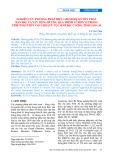
ISSN 1859-1531 - THE UNIVERSITY OF DANANG - JOURNAL OF SCIENCE AND TECHNOLOGY, VOL. 22, NO. 11C, 2024 89
RESEARCH ON CALCULATION OF SLOPE FAILURES CONSIDERING
UNSTABLE TRANSIENT SURFACE DUE TO RAIN
Trung Quan NGUYEN1, Huy Cong VU1, Ly Trieu PHAM1, Le Thuan NGUYEN2, Van Huong NGUYEN1*
1The University of Danang - University of Science and Technology, Vietnam
2Central Rural Electric Project Management Board - Central Power Corporation, Vietnam
*Corresponding author: nvhuong@dut.udn.vn
(Received: September 08, 2024; Revised: September 21, 2024; Accepted: October 15, 2024)
DOI: 10.31130/ud-jst.2024.564E
Abstract - Slope landslides are one of the natural hazards that are
gradually appearing more and more in number and intensity,
causing serious damage to people, property, and infrastructure.
Many studies have shown that climatic factors such as rainfall and
human activities are important causes of landslides. The
infiltration of rainfall changes the water content of the unsaturated
zone (Vadose Zone), thereby causing instability. In this study, a
2-dimensional slope stability model was established using the
seepage analysis module (SEEP/W) and stability (SLOPE/W),
which considers the impact of rainfall changes, the existence of
tree canopy and trunk, the soil reinforcement effect of tree roots,
water absorption of tree roots, and the impact of tree roots on soil
permeability, thereby calculating slope stability, applied to the
Dak Pring hydropower plant project (Cha Val commune, Nam
Giang district, Quang Nam province). The paper aims at a more
comprehensive and detailed approach to seepage - slope stability
calculation models than traditional solutions.
Key words - Slope erosion; unsaturated zone; rainfall; seepage;
stability.
1. Introduction
Slope landslides are phenomena in which soil, rock, or
other materials slide downward, reducing the stability of
the slope, usually occurring in adverse situations or under
the effects of human activities. This phenomenon can occur
suddenly or gradually, depending on several factors such
as topography, geology, earthquakes, erosion, seepage due
to rainfall, vegetation, human activities, among others.
Among these factors, rainfall is considered the most
common cause of landslides, especially in tropical regions.
This is because in tropical regions, rains are often
prolonged, and in mountainous areas, the soil layer
covering the bedrock has a relatively high-water
absorption. Landslides often cause serious casualties,
damage to infrastructure, loss of productive land, traffic
congestion, environmental impacts, changes to natural
landscapes, etc. Therefore, landslides are among the most
damaging natural disasters in the world. Indeed, in 1999,
heavy rains caused landslides in Vargas, Venezuela,
resulting in 30,000 deaths and affecting millions [1]. Also,
in 1999, a major landslide occurred following an
earthquake in Izmit, Turkey, killing more than 17,000
people and causing extensive property damage [2]. In
2013, landslides under intensive rainfall happen in
Uttarakhand, India, leaving more than 5,700 people
missing and causing extensive damage to infrastructure
[3]. In 2014, a landslide in Oso, Washington, USA, killed
43 people and destroyed many homes [4]. In 2015, after a
strong earthquake, many landslides occurred, affecting
thousands of people and causing significant damage to
infrastructure in Nepal [5]. In China, in 2017, a landslide
in Sichuan killed at least 10 people and left many others
missing [6]. Global estimates of economic losses due to
landslides range from $1 to $10 billion per year [7].
Meanwhile, the total annual damage caused by landslides
in Vietnam is estimated to be hundreds of billions of dongs
[8]. Nepal is one of the most affected countries in the
world, due to its mountainous terrain and complex climate.
India, Indonesia, and China also face similar problems,
with many areas prone to landslides due to their
topography and weather conditions [9 - 12].
Vietnam is considered one of the most vulnerable
countries in the Asia Pacific region to landslides. This is
mainly due to its diverse topography with many
mountainous and steep areas, along with its tropical
monsoon climate conditions. Heavy and prolonged rainfall
events during the rainy season, especially after tropical
storms, often cause landslides, affecting people, transport
infrastructure, and agricultural production. Furthermore,
unsustainable natural resource exploitation and rapid
urbanization also contribute to increased landslide risks
[13], [14]. In 2021, a landslide occurred in Hoanh Bo
district, Quang Ninh, killing two people and damaging
many houses [15]. Also in Quang Ninh, in 2017, a
landslide occurred in Tan Lac district, 5 deaths and causing
serious property damage [16]. In 2018, in Moc Chau
district, Son La, landslides caused many roads to be
blocked, affecting traffic and people's lives [17]. In 2020,
landslides after heavy rains killed 4 people and left many
missing, causing great damage to agriculture in Nghe An
[18]. In Tra Leng, Quang Nam, in 2020, there were 8
deaths and dozens of houses buried after a serious landslide
[19]. In addition, a serious landslide occurred in Rao Trang,
Thua Thien - Hue in 2020 as a result of prolonged heavy
rain due to the influence of storm No. 7 and steep terrain
characteristics.
In the context of increasing climate change, extreme
weather events such as heavy rains are becoming more
frequent, increasing the risk of landslides in many areas,
especially mountainous areas. Therefore, studying
landslides is not only a scientific requirement but also a
practical task to protect human life and property, while
ensuring a sustainable living environment. In this article,
the authors focus on a solution to prevent slope landslides

90 Trung Quan NGUYEN, Huy Cong VU, Ly Trieu PHAM, Le Thuan NGUYEN, Van Huong NGUYEN
applied to the Dak Pring hydropower plant (Quang Nam
province), considering the influence of climatic factors
over time (changes in rainfall, temperature, humidity,
evaporation, and wind) and the connection between soil,
rock, root layers, and vegetation.
2. Methodology
Up to now, there have been many studies conducted on
the mechanism of seepage and slope failure due to rainfall.
The approaches of these studies have been sorted into
different groups of methods. (1) Physical model
experiments [20 - 24]; (2) Physical model experiments with
mathematical models [25]; (3) Physical model experiments
in the laboratory to determine the physical properties of
soil, combined with mathematical modeling and field
surveys [26 - 28]. The results of the above studies have
shown that volumetric water content (VWC) and pore
water pressure (PWP) have spatial and temporal variations
in slopes affected by wet and dry cycles. The failure
mechanism of rainfall-induced landslides is mainly related
to the development of an upper moisture layer, leading to
increased pore water pressure (loss of suction or
development of positive PWP) in the soil. The increase in
PWP leads to a decrease in the shear strength of the soil,
causing slope failure. The stability of the slope is directly
affected by the changes in VWC and PWP, and these two
parameters depend on the rainfall intensity, soil
permeability coefficient, soil saturation, slope topography,
and vegetation.
Figure 1. The hydrological cycle and the main consequences of
rainfall on soil slopes [29]
In addition, vegetation cover on slopes also has a
significant influence on slope stability. The impact of
vegetation on slope stability takes two general forms:
mechanical and/or hydrological. The mechanical impact is
mainly related to the root system (depth, width, and
texture); the roots anchored in the soil will support the
above-ground biomass, creating a reinforced soil frame,
helping to reduce the possibility of slope failure. In
addition, root systems can also negatively impact slope
stability by generating additional loads (due to roots and
trunks), increasing moisture retention leading to increased
pore water pressure, reducing soil strength, and weakening
soil structure. Moreover, the weight of trees and wind
affecting the equilibrium of the slope should also be
considered. Figure 1 shows a diagram of the
conceptualization of the model and the processes
influencing the slope stability assessment [29]. The
hydrological impact of vegetation on slope stability relates
to changes in soil moisture. Vegetation can reduce soil
moisture by intercepting rainfall on the ground (due to
some precipitation remaining on tree crowns and trunks)
and by absorbing water from the soil through its roots.
Conversely, vegetation also promotes water infiltration
rather than surface runoff (holding water on the surface),
which leads to increased soil moisture during and after
rainfall events, potentially destabilizing slopes.
Figure 2. Subdivisions of Vadose zone (unsaturated zone) [30]
The Vadose Zone, also known as the unsaturated zone,
is the part of the soil between the soil surface and the
groundwater table. In this zone, air and water are present
in the pores, but the soil is not completely saturated. The
Vadose Zone plays an important role in water infiltration,
gas exchange, and nutrient exchange for plants. As shown
in Figure 2, the Vadose zone consists of surface soils,
unsaturated subsurface material, and the capillary fringe
zone. The subsurface material consists of partially
weathered soils and unweathered parent material. The
Vadose zone can be very shallow (less than 1 m) or very
deep (extending hundreds of meters or more), depending
on the depth of the groundwater table [30].
Currently, there are stability analysis methods,
including the Limited Equilibrium Method (LEM), Finite
Element Method (FEM), and Finite Difference Method
(FDM). Among the above methods, LEM is more
commonly used than other methods.
The Factor of Safety (FoS) according to the LEM is
determined through considering the moment equilibrium
and/or force equilibrium (vertical and/or horizontal).
Depending on the approach, the limit equilibrium method
is divided into the following methods: Fellenius, Ordinary,
Bishop simplified, Jambu corrected, Morgenstern–Price,
and Spencer (Table 1). The sliding body is divided into
several sections (soil columns), and the stability of each
section is analyzed (considering the normal and tangential
forces on both sides of the soil column). Then, all the
sections are combined to calculate the factor of safety for
the assumed sliding surface. To obtain the smallest safety
factor (corresponding to the most dangerous sliding
surface) of the slope, several assumed sliding surfaces are

ISSN 1859-1531 - THE UNIVERSITY OF DANANG - JOURNAL OF SCIENCE AND TECHNOLOGY, VOL. 22, NO. 11C, 2024 91
analyzed to determine the smallest stability factor. The
method is suitable for both homogeneous and
heterogeneous slopes, complex stratigraphic conditions,
and considers non-uniform pore water pressures, a variety
of linear and nonlinear shear strength models, along with
almost any sliding surface geometry, loads (distributed and
concentrated), earthquakes, structural reinforcement
(anchors, geotextiles, roots), and cracks on slopes.
Table 1. Sliding surfaces and equilibrium forms of the methods
in the Limit Equilibrium Method [31]
Method
Sliding surface
Equilibrium
Circular
Non-Circular
Moment
Force
Fellenius
yes
no
yes
no
Ordinary
yes
no
yes
no
Bishop
simplified
yes
no
yes
vertical
Jambu
simplified
yes
yes
yes
vertical and
horizontal
Morgenstern–
Price
yes
yes
yes
vertical and
horizontal
Spencer
yes
yes
yes
vertical and
horizontal
In this paper, the Seep/W and Slope/W modules in the
GeoStudio software were applied for simulation. The
combination of these two modules brought a
comprehensive analysis, which mainly included the
following two steps: (1) the FEM of the Seep/W module
was used to analyze the unsteady seepage caused by rain
and other climatic factors such as temperature, humidity,
evaporation, wind velocity, especially considering the
characteristics of vegetation cover on the slope; (2) The
unsteady seepage results from the Seep/W module will be
imported into the Slope/W module to analyze and
determine the factor of safety by the LEM. Specifically, the
total LEM of Morgenstern–Price has been selected; the
stability factor satisfies both the force balance (vertical and
horizontal) and the moment balance (Figure 3).
Figure 3. Factor of safety according to the Bishop, Janbu, and
Morgenstern-Price or Spencer methods [31]
3. Dak Pring Case Study
3.1. Study Area
Dak Pring Hydropower Plant is located in Cha Val
Commune, Nam Giang District, Quang Nam Province,
approximately 40 km west of Thanh My Town, Nam Giang
District, and 160 km northwest of Tam Ky City, with
coordinates 15038’19,46” N; 107033’14,69” E. The project
began in April 2015 and was completed on 30 May 2017,
with the main task of generating electricity. It has a
capacity of 7,5MW (02 units) and an average annual
electricity output of 30,47 million kWh.
Figure 4. Landslide location seen from the yard of Dak Pring
Hydropower Plant (November 2017)
After heavy rainfall event from 4 November 2017 to 6
November 2017, the natural hillside upstream of Dak Pring
Hydropower Plant experienced two landslides, each about
10m wide, 20m long, and 6m deep. The material in these
two slides moved down about 5m -10m into the plant’s
yard and remained partly on the slope upstream of the plant
(Figure 4).
3.2. Geological conditions
Table 2. Physical and mechanical indicators of soil and
rock layers [32]
Layer
w
C
E
K (m/s)
(kN/m3)
(degree)
kPa
(kg/cm2)
edQ
18
19
27
90
0.20
5x10-7
IA1
19
21
24
150
0.25
1x10-6
IA2
25.4
26.6
50
3,000
0.40
5.8x10-6
IB
27.0
33
200
20,000
0.30
1.2x10-5
IIA
28.2
40.4
350
70,000
0.25
3.5x10-6
IIB
28.4
42
450
100,000
0.20
5.8x10-7
w - Unit Weight;
- Internal Friction Angle; C – Soil
Cohesion; E – Elastic Modulus;
- Poisson Ratio;
K – Coefficient of Permeability.
Figure 5. Topographical and geological conditions of
Dak Pring project
The typical cross-section is selected at the factory location,
where the landslide occurred with borehole DP22, including
06 stratigraphic layers: the remnant slope layer and the
strongly weathered rock zone (edQ + IA1) with a thickness of
7-10m, which is prone to landslides; the strongly weathered
rock zone (IA2) with a thickness of 1-2m; the IB rock zone is
0-2m thick, below is the IIA rock zone belonging to the Ben

92 Trung Quan NGUYEN, Huy Cong VU, Ly Trieu PHAM, Le Thuan NGUYEN, Van Huong NGUYEN
Giang - Que Son complex, hard and solid rock; and the IIB
rock zone is hard and very hard rock (Figure 5). The
groundwater level at the foot of the slope is 2-5m below the
ground, higher than the bottom of the factory foundation and
the channel [32]. Physical and mechanical properties of soil
and rock layers are provided in Table 2.
3.3. Climate conditions
Dak Pring Hydropower Plant is located on the eastern
slope of the Truong Son Mountain and to the west of
Quang Nam province, so it has a tropical monsoon climate.
The west has a different rainfall regime and hydrological
characteristics from the deltas to the sea in the east. The
average annual air temperature varies between 20oC ÷
28oC, the lowest temperature is 8.7oC, and the absolute
maximum temperature reaches 41oC. The average monthly
relative humidity in the area is quite stable; during the rainy
season it varies from 80% ÷ 90%. During the year, there is
a lot of sunshine from April to August; the number of hours
of sunshine in these months is usually over 200 hours; the
most sunshine is in May and June; the average number of
hours of sunshine is up to approximately 250 hours/month.
There is little sunshine from September to March, in which
the month with the least sunshine is December (less than
100 hours). During the year, there are 2 wind seasons: the
summer monsoon from May to September, with prevailing
winds from the west and southwest at an average speed of
1.46 m/s, and the winter monsoon from November to April
with prevailing winds from the southwest at an average
speed of 1.47 m/s. Annual rainfall is quite large but
unevenly distributed throughout the year. The rainy season,
from September to December, accounts for 60% ÷ 75% of
the total annual rainfall, while the dry season lasts from
January to August. In May and June, secondary rainfall
peaks appear, becoming more pronounced further west in
the study area and creating a sub-seasonal period in the
basin. The period of heaviest rainfall in the whole region is
often concentrated in October and November [33].
The climatic conditions for the analysis of unsteady
seepage flow were taken from actual data measured from
25 October 2017 to 16 November 2017, including
temperature, humidity, wind speed, and rainfall. Rainfall
data was observed at Hien station (Dong Giang) from 25
October 2017 to 16 November 2017, representing a typical
rainfall model in the study area. Other meteorological data
was taken from Tam Ky meteorological station. The
meteorological data series used in the model during the
calculation period from 25 October 2017 to 16 November
2017 is shown in Figures 6 to 9.
In addition, according to Decision 18/2021/QD-TTg 22
April 2021 of the Prime Minister on "Regulations on
projects, warnings, transmission of natural disasters and
levels of natural disaster risks", the authors conducted
slope stability calculations for four rainfall scenarios
according to four levels of natural disaster risks (RRTT)
(level I, level II, level III and level IV) due to heavy rain in
the mountainous area of Quang Nam province, as
prescribed in Table 3. The rainfall model for the four risk
levels is scaled from the typical rainfall model (Figure 9),
and the cumulative rainfall chart is shown in Figure 10.
Figure 6. Temperature graph
Figure 7. Humidity graph
Figure 8. Wind velocity graph
Figure 9. Daily rainfall graph
Figure 10. Cumulative rainfall of typical rainfall model
(November 2017) and 4 levels of RRTT
Table 3. Maximum rainfall of scenarios
November
2017
RRTT
Level I
RRTT
Level II
RRTT
Level III
RRTT
Level IV
235,8 mm
(05
November)
(100-200)
mm/ 24
hours
(200-400)
mm/ 24
hours
Over
400mm/
24 hours
Over
400mm/
48 hours
Maximum daily rainfall used for scaling for RRTT levels (mm/
24 hours or 48 hours)
235,8
(05/11/17)
200
300
400
400
RRTT: Natural disaster risk.
Source: Decision 18/2021/QD-TTg dated April 22, 2021 of the
Prime Minister on “Regulations on forecasting, warning,
transmitting information about natural disasters and levels of
natural disaster risk”.

ISSN 1859-1531 - THE UNIVERSITY OF DANANG - JOURNAL OF SCIENCE AND TECHNOLOGY, VOL. 22, NO. 11C, 2024 93
3.4. Vegetation conditions
The data needed to consider the influence of land cover
conditions in the seepage and stability analysis include
Leaf Area Index (LAI) and Root Depth. The study area is
in the Western Truong Son Mountain range, a low
mountainous area, with a natural elevation of 400 m to
700 m, slope varying from 20o to 45o, and dense vegetation
including climbing plants and tropical woody plants. Refer
to the research results on LAI [34] and Root Depth [35].
For mature tropical woody plants, the cover system
conditions were determined to be 2.0 and 0.4 m,
respectively.
4. Results and Discussion
In this study, the factors assigned to the seepage
problem (rainfall, temperature, humidity, and wind) are
time series data. Therefore, the results of the seepage
analysis according to the unsteady seepage, meaning that
the results of determining the infiltration flow
characteristics change depending on the time of extraction
of the results.
For the November 2017 rainfall event scenario using the
observation timeseries data from 25 October 2017 to 15
November 2017, the authors defined the calculation period
as 24 hours (1 day and night) with 22 steps. The slope
stability calculation for the November 2017 scenario uses
the Slope/W module connected to the Seep/W module to
analyze the seepage flow due to rain, while taking into
account the climatic conditions (temperature, humidity, and
wind speed) and vegetation cover (Leaf Area Index and Root
Depth) as outlined in Section 3.4. The FoS results at step
#15, as of 8 November 2017, are shown in Figure 11c. The
results of the model show that there are 6 calculation steps
(#14 ÷ #19) with FoS less than 1, which proves that the
rainfall event in November 2017 will cause the landslide of
the Dak Pring hydropower plant. This result is consistent
with the fact that the slide has occurred. In addition, the
location of the slide that occurred was located on the
simulated cross-section (Figure 11a) consistent with the
simulation results in Figure 11b. This shows that the slope
stability simulation model has high reliability.
The authors also calculated the stability of the rainfall
process corresponding to 4 levels of RRTT (according to
rainfall intensity) according to Decision 18/2021/QD-TTg.
The results of the FoS chain according to 22 calculation steps
are listed in Table 4. The results illustrate the smallest FoS
for the most dangerous sliding surface for the RRTT levels
(levels I to IV) respectively, as shown in Figures 12 to 15.
Figure 11a. Actual sliding surface in Dak Pring
Figure 11b. Seepage calculation results (velocity vector and
permeability gradient) of slope at step #15 (8 November 2017)
Figure 11c. FoS result at step #15 (8 November 2027)
Figure 12a. Seepage calculation results (velocity vector and
permeability gradient) of slope with RRTT level I at step #15
Figure 12b. FoS result with RRTT Level I at step #15
Figure 13a. Seepage calculation results (velocity vector and
permeability gradient) of slope with RRTT level II at step #15





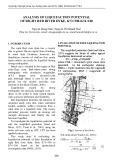
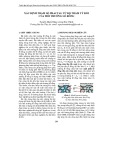

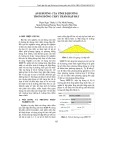
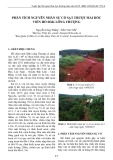


![Quy hoạch tổng thể Cà Mau: Tài liệu [mới nhất/chuẩn nhất]](https://cdn.tailieu.vn/images/document/thumbnail/2025/20250827/tghong1621@gmail.com/135x160/49401756278390.jpg)

![Bài giảng Hàng hải địa văn [chuẩn nhất]](https://cdn.tailieu.vn/images/document/thumbnail/2025/20250729/vijiraiya/135x160/43361753782101.jpg)


![Atlas tài nguyên nước Việt Nam: Tài liệu [Mô tả/Hướng dẫn/Chi tiết]](https://cdn.tailieu.vn/images/document/thumbnail/2025/20250715/vijiraiya/135x160/348_tai-lieu-atlas-tai-nguyen-nuoc-viet-nam.jpg)
![Hệ thống câu hỏi ôn tập Vùng kinh tế [chuẩn nhất]](https://cdn.tailieu.vn/images/document/thumbnail/2025/20250709/kimphuong1001/135x160/76921752140578.jpg)





